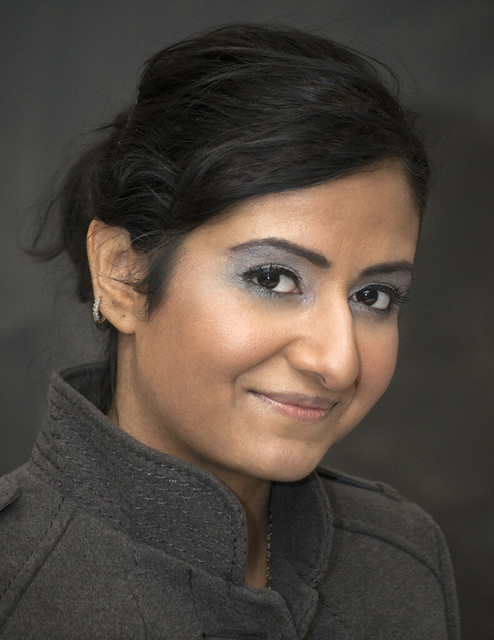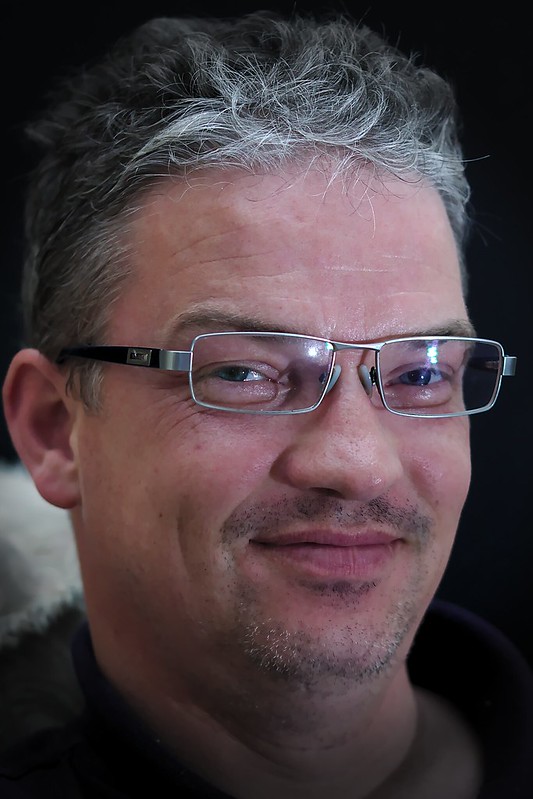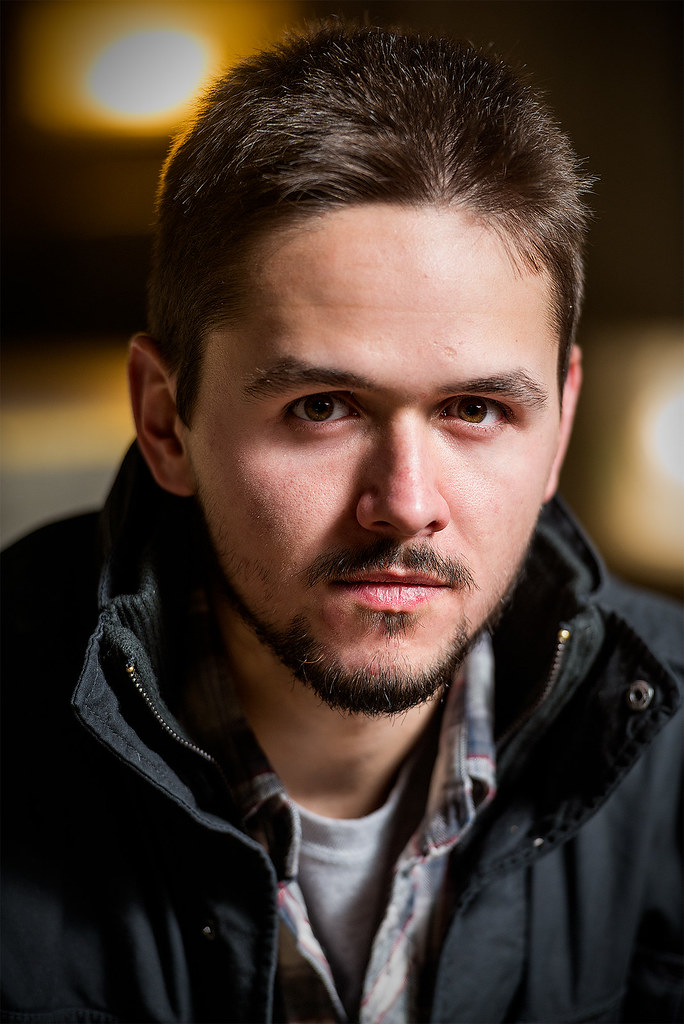How did I do? Found this tricky, couldn't work out how to get rid of the reflection in the glasses. Just working with one speedlite did have ambient top right(daylight strip) diffused by shallow corner. flash just off shoulder low aimed at ceiling using built in deflector. Am I asking too much? Did use a cpf to lessen reflection.
darktable-finIMG_3608
Results 1 to 15 of 15
Thread: First Portrait
-
23rd April 2015, 01:24 AM #1
First Portrait
-
23rd April 2015, 01:46 AM #2
Re: First Portrait
Nice effort. You can find many tutorials on photographing individuals with eyeglasses. You can post-process afterwards or re-position your main light to the opposite side of the face.
-
23rd April 2015, 08:57 AM #3
Re: First Portrait
Cheers John, makes a bit more sense did keep moving the flash, to no real joy. Think I need a second flash keep getting held back by one side. For this as the ambient was pretty unmoveable, with a massive cage in front not sure I had much more to work with. As for pp pfft my skills aren't that good had a crack but just looked worse.
-
23rd April 2015, 09:22 AM #4

- Join Date
- Apr 2012
- Location
- Dunedin New Zealand
- Posts
- 2,697
- Real Name
- J stands for John
Re: First Portrait
I think it does depend on what editor you have and you need to be able to adjust the size of the brush and its strength and change the pick-up source frequently.
I have PSPx6 and the settings I ended with were size 5 pixels though I started bigger for the actual main reflection of the light ...hardness 24% ... Opacity 38%
You working on a larger file could use a bigger brush size to speed up the process. Here it is just 534 wide by 800 high and I worked with just the eyes filling my screen. [120% ... 70% shows me the whole picture ]

-
23rd April 2015, 09:24 AM #5
Re: First Portrait
Stef,
What software package are you using for editing? Another editing method advocated by Scott Kelby and a few other photographers is to have the model remove their glasses , while not moving; you take a photo with and without and it should help with the later editing. You can use a program such as Elements to later photomerge the two images.
-
23rd April 2015, 10:25 AM #6
Re: First Portrait
Welcome to the world of portraiture. First learning - glasses are a pain to shoot, so having the subject remove them is usually the best plan. They tend to do a few things that you don't want; reflections (as is the case in your shot) and the distortion of anything behind them. They can also cast shadows that can be distracting; if you look at your subjects eyes, they have what I refer to as "goofy shadows", cast by the subjects lenses and frames. If the glasses are part of the personal of the person being photographed, removing them from frames is sometimes done. Speaking of distracting, the white spot behind your subject that is camera left is definitely a bit distracting.
Depending on what you are trying to do with the image, there are two major directions in portraiture lighting. One is what you see in commercial headshots, where the lighting is very flat and even, then the objective is to have a shadowless image. If the shot is a more traditional portrait, then shadows to accentuate specific facial features or looks are used. In this shot you have a fairly noticeable dropoff as the top of the head has significantly more light than the bottom. I don't thing that is necessarily working for you.
I do like the way your subject's eyes are natural (not too open and not too closed), that gives a much more "comfortable" look.
I find your crop is a touch too close for my taste (looks too much in the ID card / passport style). Leaving a bit more clothing in often works better compositionally than getting too close.
You suggest that you need a second flash; I'd agree that a second light would help, but that doesn't necessarily mean you need a flash; I often use a reflector as my fill light. A decent sized piece of white foam core or coreplast is a lot less expensive than a second lighting setup. Collapsible commercial reflectors area my preferred choice; and while they come in different shades and colours, most of my portraiture is done with a white reflector. If you are shooting men, a silver reflector can make the lighting look a bit "edgier". The nice thing about a reflector is that you don't need to worry about lighting ratios; reflected light tends to not overpower your main light source.
A good place to start with your main light is the 45 / 45 position; flash either camera left or camera right 45° from the camera plane, pointing down at your subject at a 45° angle. The reflector or second flash should be positioned so that it comes in from lower down and points up a bit to fill in things for you.
As for a shooting angle, you'll have to play around with that a bit. My usual "safe" choice is to be a touch about higher (an inch or two) than eye level.
-
23rd April 2015, 03:06 PM #7
Re: First Portrait
Hi John, thanks for that and c&c have to admit as I'm still very early in this not really got into the next level. Seeing what you've done makes a lot more sense as I've tended to use niche software I've not got out of the raw editors(I'll address this in reply to the other John). You've inspired me now. Even though I feel whilst a good first attempt I suspect it's not really worth investing too much time in it.
Hi John as above I now realise I've probably gone beyond raw editors. As I've been using Linux I've been using darktable as my lightroom and raw editor. Trying to spot heal was just too much. I now realise I probably need to go to the next level instinctively I think of gimp just avoided it a little bit due to bit loss. Starting to think I need to reassess this either by using Windows or seeing if another software fits better(just noticed aftershot pro has linux).
Many thanks Manfred that's given me plenty to digest. I've got boards so probably could of attempted a far better reflected fill. You really have made me look at this differently. Weird thing in regards to eyes I seem to get them to be genuine, not even sure how. I had a few that looked forced but lightened him up(my brother) inadvertently.
In regards to drop off again something I completely missed. Knowing I had ambient top left didn't even think it through. I was initially trying to go a bit dramatic on the right had one but too hot on right and not enough contrast on left . I realise now the flash was just too low at waist height and a little too straight, aimed at the ceiling with the deflector facing him.
Cropping, mmm think the 105 may of been a touch close also lost a little more straightening the glasses.
Your post has been very insightful and made me fancy another go now. Just not sure how many times he'll let me.
-
23rd April 2015, 10:02 PM #8
Re: First Portrait
I haven't tried photographing anyone with glasses yet, but my grandmother (who always wears glasses that darken in bright light) took the lenses out of an old pair, and uses those for pictures. Works great, but I realize not everyone has an old pair of glasses hanging around for this purpose.
 I can only imagine the headache glasses create for the photographer!
I can only imagine the headache glasses create for the photographer!  Good luck!
Good luck!
-
24th April 2015, 05:30 AM #9

- Join Date
- May 2012
- Location
- Perth, Western Australia
- Posts
- 130
- Real Name
- David
Re: First Portrait
Strobist is your friend.
http://strobist.blogspot.com.au/2006...r-glasses.html
However, with this setup, to get reasonably even lighting, you'd need that reflector (or a white wall or something on opposite side to flash).
-
24th April 2015, 12:50 PM #10

- Join Date
- Jan 2015
- Location
- Kingsville, Texas
- Posts
- 877
- Real Name
- Dean
Re: First Portrait
A simple solution for this is to raise the light slightly and have the subject lower his chin slightly. Worked well when we shot with film.
-
24th April 2015, 07:56 PM #11
Re: First Portrait
A few more thoughts, now that you have confirmed how you shot. Next steps are more related to how you want to proceed with portraiture; either a more ad-hoc approach (where the equipment / method you are using is fine) or something a bit more controlled (where you will have to invest in a bit of lighting gear).
I do use bounce light for a lot of my photography, but that will only be in situations where I am not able to set up and use a more traditional lighting setup, for instance in event photography (I use several other portable flash modifiers as well). The technique can give you a large light source (wall or ceiling), but can be problematic as changing locations can change your light quite drastically. The fill card also works for reducing / eliminating shadows from overhead lights, but this means you really need to have your flash more or less at eye level, so you have a tradeoff to deal with there.
Part of the issue with this image is the position where your directed the bounce from; it was too close to your subject (and the light source was too close as well) and this resulted in the drop off of light that you see. If your light source is further away in bounce, the drop off is less noticeable as a percentage basis (inverse square law at work); so try varying the angle that you are pointing the flash at the ceiling (I often shoot almost straight up; you need a higher power setting, but the lighting can be more pleasing).
If you want to get serious about this type of photography, you might want to consider getting a light stand with an umbrella holder and an umbrella. This in combination with a reflector gives you a fairly inexpensive way of getting pro quality lighting. This is one of my first shots with a single Speedlight using a white reflective umbrella and a white reflector, done about 5 years ago.

The equipment other than the Speedlight cost me around $100CAD. I don't know what you are shooting with, but I assume you've got an off-camera triggering device?
As mentioned before, try changing the angle you are shooting at. You are trying to use three separate light sources in this shot:
1. Diffuse reflected flash - bounce from the ceiling;
2. Direct flash - via the card on the flash directed at the face; and
3. Ambient light - no idea what it is here, but I suspect that there was little or now ambient contribution to this image. If ambient is anything other than daylight that is near to the 5000K - 5500K that your flash outputs you will be into a mixed light situation that may or may not give you a lighting situation that you are looking for.
If you want ambient light to affect your image, you have to set you shutter speed, aperture and ISO to an appropriate setting so that the ambient light actually impacts the image. This usually means shooting at a shutter speed below the synch speed (this is known as "dragging the shutter".
I do a lot of my portraiture with a 105mm lens, but I shoot full frame, so that works for me. I don't know what camera you are shooting with, but a short telephoto (FF of 85mm or longer focal length) is generally going to give you a more pleasing looking shot.
I do notice you've shot from slightly below eye level. I tend to shoot from at eye level to slightly above for most of my work. I find that this usually give a bit better chin definition.
-
1st May 2015, 12:42 AM #12
Re: First Portrait
Thanks Manfred for such a detailed reply.
Think my next investment is into lighting/reflection love what you achieved. I'm on entry canon rebel 4 think on the other side, 650d here so crop sensor. So at moment using canon system but toying of doubling up flash(thinking yog...)with triggers just feel it'll cover most eventualities.
Difficult to describe ambient I know its there flash deepened the shadow on left in the drop off. It's a 6ft daylight tube(bird light) set in 2 ft recess to his top right about 8ft away. Just voicing this thinking it probably didn't help, think I need to invest.
I have to admit didn't work the positioning as well as I should of, certainly not going to be my main focus but will definitely try portraits again. Thank you again certainly made me understand my lighting/reflector limits at the mo.
-
1st May 2015, 01:12 AM #13
Re: First Portrait
I don't know if it is just me but, I prefer my portraits of males to have the eyes in line with the nose. However in portraits of females, like Manfred's above, having the eyes looking in other than the direction of the face looks coquettish and cute. Maybe it looks that way to me regarding male portraits also but, I seem to feel that it is a shifty look. In photography, what is good for the goose is not necessarily right for the gander (sorry about the mixed metaphors)...
-
1st May 2015, 02:06 AM #14
-
1st May 2015, 04:06 AM #15
Re: First Portrait
Now, I would buy a car from that guy


 Helpful Posts:
Helpful Posts: 

 Reply With Quote
Reply With Quote

